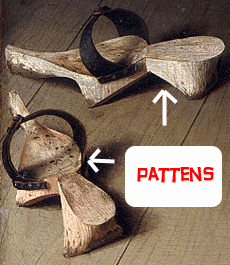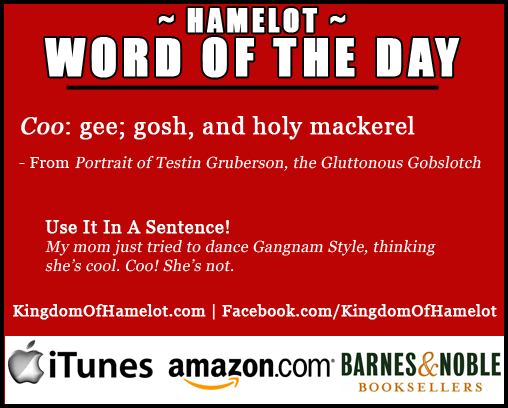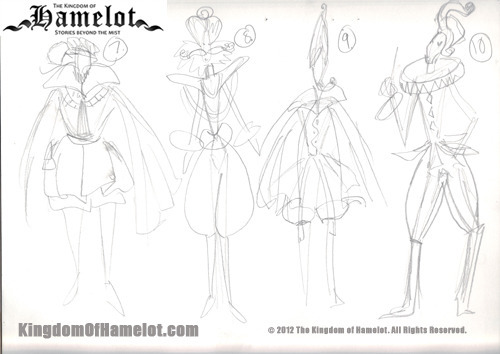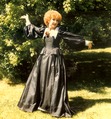Sharon Watts's Blog, page 4
December 5, 2012
Life in the time of Hamelot: Fashion
This is an ongoing series about life in the time of Hamelot - the Elizabethan era – based on information given to us by Kingdom of Hamelot creator Sharon Watts. Sharon has studied Elizabethan history and Shakespeare extensively and was a guest lecturer to schools on behalf of the Utah Shakespeare Festival.
 In our next round of eBooks, we’ll be introducing two of the folks in Hamelot who keeps the Royals looking good: Master Colin Stitcheson, the couturier, haberdasher and milliner (he’s a fancy tailor and designer), and Hyper Rosie Opia, the farsighted hairdresser.
In our next round of eBooks, we’ll be introducing two of the folks in Hamelot who keeps the Royals looking good: Master Colin Stitcheson, the couturier, haberdasher and milliner (he’s a fancy tailor and designer), and Hyper Rosie Opia, the farsighted hairdresser.
In Elizabethan times, there were sumptuary laws which dictated what you could and couldn’t wear, depending upon your social status. Nobleman could dress elaborately and in rich colors. A common person had to wear drab colors and handmade clothes. (Don’t worry: we’ve relaxed the rules in the Kingdom of Hamelot. Feel free to wear your bright purple Crocs if you must, commoner.)
The upper class almost always wore ruffs and other showy stuff. Only royalty wore purple as a rule but Queen Elizabeth I wore every color of rainbow. This woman was a clothes horse. It was said that when she died, she had 500 dresses in her wardrobe.
The women of the time wore wigs and painted their faces with thick, gobby makeup which contained alum, which we use in pickling, and an ingredient derived from lead, which causes lead poisoning. How’s that for healthy?! Elizabeth I loved wearing cosmetics. She covered her face in white and painted red on her cheeks. When she died, folks said she had 1/4 inch of white makeup encrusted on her face.
Many women would shave their hair back from forehead. They might have done this to help with wearing a wig.
Ladies carried perfumed kerchiefs or wore pomanders, hollow balls filled with herbs, dried cloves or lavender. As we mentioned in a previous post, people didn’t bathe or wash their clothes very often, and these fragrances helped ward off the stink.
 Both men and women wore pattens, which were strap-on clogs that went over their satin slippers. These wooden platforms would help raise them up out of the manure and mud (and the contents of chamber pots being thrown out of windows!) that covered the streets of the cities and villages.
Both men and women wore pattens, which were strap-on clogs that went over their satin slippers. These wooden platforms would help raise them up out of the manure and mud (and the contents of chamber pots being thrown out of windows!) that covered the streets of the cities and villages.
Women wanted to have skinny waists. One way to create the appearance of that was to make their hips and skirts poof out. Women wore bum rolls under their petticoats. They were made of quilted material and were several layers thick. They added a stomacher plate over their dresses to hold their tummy flats and farthingales frame to hold the skirts out. Now the farthingales frame made it difficult to sit or even get through some doorways. But one added bonus – it provided a bit of privacy when they had to go to the bathroom. Some even squatted in the middle of the street to do their business. We wish we were making that up, but we’re not.
Share and Enjoy
• Facebook • Twitter • Delicious • LinkedIn • StumbleUpon • Add to favorites • Email • RSS

We are the $.99
 There’s a great article in TIME Magazine (you need to be a subscriber to view the whole thing) about the self-publishing industry. The article puts the whole eBook/self-publishing movement into perspective:
There’s a great article in TIME Magazine (you need to be a subscriber to view the whole thing) about the self-publishing industry. The article puts the whole eBook/self-publishing movement into perspective:
Since 2006, annual production of self-published titles has more than tripled, according to the research firm Bowker, and it now tallies more than 200,000; within that category, e-book self-publishing is growing at a rate nearly four times that of print. To a growing movement of indie authors–many of them working in pulpy genres like mystery, fantasy and romance–self-publishing is no longer a mark of shame but a route to freedom, affirmation and a potentially vast pool of readers: buyers who are willing to risk a few dollars on an unknown author who doesn’t happen to meet the (often opaque and arbitrary) standards of traditional publishing houses.
We spent two years talking to people and investigating a host of different ways that we could bring the stories from the Kingdom of Hamelot to the world. We considered trying to sell it outright. We flirted with building an expensive app. And in the end, we went with the solution that would cost effective, give us a lot of freedom and allow us to be part of a revolution in publishing.
This isn’t a business for those who need certainty. We don’t know exactly what the path ahead looks like, but we get up every day and take the next logical step. Our communications, marketing and production plans are constantly modified by the changing marketplace, toolsets and devices. Our eBooks will probably look outdated and simple in a year. We look forward to that. It means that the technology has improved. We will republish and make improvements. We can do that. We are in the driver’s seat.
There are those who are happy with the way things are and those who are excited for what comes next. Put us in both categories. That being said, we aren’t going to sit around and lament the death of the printed book or the way things used to be. Publishing is evolving. We are a part of that. In our small way, we are helping to mold the future. It is an exciting time for storytelling. It is definitely an exciting time for us.
Share and Enjoy
• Facebook • Twitter • Delicious • LinkedIn • StumbleUpon • Add to favorites • Email • RSS

December 3, 2012
New story on Wattpad: Hyper Rosie Opia
 Want to get a sneak peak at one of the next stories we will publish in February? Sharon has released the story about Hyper Rosie Opia, the farsighted hairdresser of Hamelot on Wattpad, an online writing community. Would you let Rosie cut and style your hair?
Want to get a sneak peak at one of the next stories we will publish in February? Sharon has released the story about Hyper Rosie Opia, the farsighted hairdresser of Hamelot on Wattpad, an online writing community. Would you let Rosie cut and style your hair?
Read about Rosie!
http://www.wattpad.com/9213133-portra...
Share and Enjoy
• Facebook • Twitter • Delicious • LinkedIn • StumbleUpon • Add to favorites • Email • RSS

Sneak peak! Updated character sketches
Can you see these characters coming to life as illustrator Tasia Duckart keeps refining them? We have a few changes to make – notably, Rosie’s hair will change dramatically, and Stitcheson’s mustache will shorten quite a bit. We might also make a couple small changes. For example, did you know that the toes of men’s shoes in Elizabethan times were square? Details, details!




Share and Enjoy
• Facebook • Twitter • Delicious • LinkedIn • StumbleUpon • Add to favorites • Email • RSS

November 30, 2012
Hamelot word of the day: Coo!
For those who haven’t checked out our eBooks yet, one of the great features is our vocabulary list of challenging or odd words at the end of the story. And if your eReader supports this functionality (I’m looking at you, iPad), you can simply click on one of the highlighted words in the story, and it will “jump” to the definition in the vocabulary list.
We love some of the words Sharon has chosen to put in the stories. Today we give you the word “coo!” Drop it in a conversation today and see what folks say.

Share and Enjoy
• Facebook • Twitter • Delicious • LinkedIn • StumbleUpon • Add to favorites • Email • RSS

November 29, 2012
Sneak peek! Early sketches of Master Colin Stitcheson
Meet Master Colin Stitcheson, Hamelot’s Master Couturier, Haberdasher and Milliner. Okay, he’s a really, really good and popular tailor and designer. He’s the Marc Jacobs meets Kenneth Cole meets Michael Kors … well, you get the drift. Heidi Klum and Tim Gunn would be asking for his advice if he lived in the present day.
Stitcheson will also be in our next series of eBooks, due out in February. Here are illustrator Tasia Duckart’s early sketches of him. What do you think the designer to the Monarch would look like? What would he wear?



Share and Enjoy
• Facebook • Twitter • Delicious • LinkedIn • StumbleUpon • Add to favorites • Email • RSS




